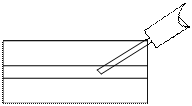
Radiasun is the leading manufacturer of cable and satellite meters in the world. Radiasun delivers the most satisfying products and services to the customers all over the world, with our own brands name, and also provides OEM and ODM for the most famous brands in the field.

AV6471 Fusion Splicer-Basic Operation
AV6471 - Fusion Splicer;
1 Power Connection-fusion splicer
Battery power and DC power were supplied by AV6471 fusion splicer to provide convenience, and the DC power was connected to the AC power through an adapter of the fusion splicer, please make sure the voltage of AC power is 110V- 240V! When the Fusion splicer was connecting the DC power, the battery was charged.
2 Splicing Parameter Setting-fusion splicer
Turn on the power of fusion splicer and then the instrument begin self-checking. If everything was ready, fusion splicer mode would be entered, the display on the screen is as figure 2-2.
2.1 Main Menu-fusion splicer
Enter The Main Menu of fusion splicer
In the fusion splice mode, press the![]() key and the instrument will enter the menu mode. The screen displays the main menu as figure 7-1.
key and the instrument will enter the menu mode. The screen displays the main menu as figure 7-1.
Functions in the Main Menu
The symbol is a highlight rectangle which can be moved up or down by![]() or
or![]() key. Functions in the main menu are as follows:
key. Functions in the main menu are as follows:
“Fiber Type”: To select fiber type.
“Para. Group”: Select the discharge condition group, adjust the discharge parameters.
“Heat Time”: Adjust heating time.
“Splice mode”: Auto, semiauto, manual.
“Setup”: Include CMOS setting, language selection, time setup, tension test setting, and power save, restore factory settings.
“Test”: Arc Power, Overlap Test, Bright Setup, Motor Adjust.
“Maintenance”: Display the splice results or number of discharges in the memory and clear the pole.

Figure 7-1
Return
In the main menu, if the![]() key was pressed, the splice mode would be returned to fusion mode.
key was pressed, the splice mode would be returned to fusion mode.
2.2 Enter into the parameter adjustment sub-menu-fusion splicer
After the main menu was entered, the fiber type option could be get by![]() or
or![]() .
.
The menu as following:
SM: To save single-mode fiber splicing parameter groups. 10 groups in total: 01~ 09 which can be changed.
MM: To save multi-mode fiber splicing parameter groups. 10 groups in total: 01~ 09 which can be changed.
DS: To save dispersion shift fiber splicing parameter groups. 10 groups in total: 01~ 09 which can be changed.
NZDS: To save nonzero dispersion shift fiber splicing parameter groups. 10 groups in total: 01~ 09 which can be changed.
Para. Group: The current fusion splice parameters group.
2.3 Switch between Splice Parameter Groups-fusion splicer
We give an example on how to select the SM1 splice parameter group to clean the electrodes below.
a) As the screen in figure 7-1, move the cursor to Fiber type option with![]() key or
key or![]() key, and select "SM" with
key, and select "SM" with![]() or
or![]() .
.
b) Move the cursor to "Para. Group" with![]() key or key, and select "01" by press
key or key, and select "01" by press ![]() key or
key or ![]() key.
key.
c) Press![]() to back, and all are OK.
to back, and all are OK.
2.4 Adjustment of Splice Parameters-fusion splicer
Entering modification menu
If the parameters in SM0 group need to be adjusted, please select the "Fiber Type" option or "Para. Group", and press ![]() to enter menu of adjustment of splice parameters.
to enter menu of adjustment of splice parameters.
Specification of Splice Parameters
All items in the parameters group as table 7-1.
Parameter Modification:
a) Use the ![]() or
or ![]() key to move the cursor to the item that needs to be adjusted, and then it means this parameter could be modified.
key to move the cursor to the item that needs to be adjusted, and then it means this parameter could be modified.
b) Then adjust the parameter to the ideal value with ![]() or
or![]() key.
key.
c) The other parameters can be modified in the same way.
Table 7-1
Item |
Range |
Unit |
Default Value |
Prefuse Time |
00~99 |
10ms |
05 |
Fuse Time |
00~99 |
100ms |
14 |
Prefuse Power |
00~99 |
0.1mA |
30 |
Fuse Power |
00~99 |
0.1mA |
30 |
Overlap |
00~40 |
2µm |
07 |
End Angle |
0.5~2.0 |
1.0° |
2.0 |
GAP |
00~09 |
2µm |
04 |
3 Adjustment of Splice Power-fusion splicer
This part gives instructions on how to achieve low splice loss in different environment conditions.
a) The recommended parameter group is decided according to the fiber gap of arc test. The gap length: 015~025.
b) Parameter modification in different circumstances.
Modify the pre-fusion current and the fusion current in the discharge parameter group, and make the value of arc test meet the requirements in step b, thus gaining a low loss. The parameters will reduce at a high temperature and increase at a low temperature.
4 Fiber Operation-fusion splicer
Step 1-fusion splicer: Before splicing, thread the fiber through the optical fiber protection sleeve.
Step 2-fusion splicer: Remove fiber coating, and then brush the bare fiber with alcohol-soaked cotton swab. The typical bare fiber length is 20mm.The concentration of the alcohol should heavier than 905.
Step 3-fusion splicer: Cut the bare fiber using the cleaver. The typical value of the cleaver length is 10mm~16mm.
Step 4-fusion splicer: Open the shield and fiber holder clamp carefully. Set the fiber in the V-groove and the fiber holder on the holder mount. At the same time, note that the tip of the bare fiber does not touch anything. Make sure fiber is at the bottom of the V-groove. If not, reset the fiber.
Step 5-fusion splicer: Set the other fiber in the same way. Put the shield down carefully.
Note:
a) Set the other fiber in the same way. Put the shield down carefully.
Fiber

Figure 7-7 Wrong way to install
b) The tip of the coating fiber should keep a distance from the bare fiber mount.
 Figure 7-8
Figure 7-8c) To be sure the coating fiber was pressed tightly by the hold clamp. The shield was closed, the fiber should be pressed on the V-groove by the shield.
5 Arc Power Test-fusion splicer
Arc Power Test is very important for obtaining low splice loss. So before splicing, the test should be done. See the details in the appendix A.
6 Splicing Operation-fusion splicer
There are three splicing modes for selection: Manual, Semi-auto and auto splicing mode.
6.1 Manual splicing mode-fusion splicer
(1) Strip, clean and cleave the optical fibers.
(2) Open the shield.
(3) Lift the fiber clamps.
(4) Place the optical fibers in the V-grooves.
(5) Carefully close the V-groove clamps. Ensure the bare fibers are seated at the position between the V-groove and the electrodes.
(6) Carefully close the fiber clamps and then the shield.
(7) Decide if the end face of fibers is good or bad.
(8) Press the![]() key. The fibers move forward to their initial gap. Do gap adjustment. If either of the two end face angles is more than the preset value, an error occurs. Press the
key. The fibers move forward to their initial gap. Do gap adjustment. If either of the two end face angles is more than the preset value, an error occurs. Press the![]() key and prepare the fiber again.
key and prepare the fiber again.
(9) Press![]() key and "ALIGN" will be displayed on the screen and the splicer will align the fibers automatically. The buzzer will beep and the screen will display "OK" after the operation is done.
key and "ALIGN" will be displayed on the screen and the splicer will align the fibers automatically. The buzzer will beep and the screen will display "OK" after the operation is done.
(10) Press![]() key to end this splicing operation. The result of estimated loss is displayed on the screen.
key to end this splicing operation. The result of estimated loss is displayed on the screen.
6.2 Semi-auto splicing mode-fusion splicer
The difference between semi-auto and manual splicing mode is whether the splicer automatically puts the two fibers end profiles to the screen center or not. We advise the user to take the auto and Semi-auto splicing mode except for special-type fiber.

Figure 7-7

Figure 7-8
6.3 Auto splicing mode-fusion splicer
"READY" is displayed on the screen.
(1) Do the same steps as in section 7.6.1: (1), (2), (3), (4), (5), (6), (7).
(2) Close the shield and the splicer will exercise Clean, Gap, Align, Fusion and Tension Test functions automatically. The result will be displayed on the screen as Figure 7-7 and Figure 7-8.
Notes:
1. Auto splicing mode is convenient, so we advise the user to take the auto splicing mode.
2. The splicer has the checking function of fiber cutting angle and fiber end face, when it works in Semi-auto or auto splicing mode. The quality of fiber end and face has enormous impact on the loss of the contacting point; so efforts should be mad as possible to make the end face plane, and the angle of the place with the fiber cross-sectional plane should be less than 1◦.
7 Estimated Splice Loss-fusion splicer
Splice loss could be estimated by observing the splicing operation and the video of the spliced part. If spliced part is abnormal (the diameter is bigger or smaller or etc.), the fiber should be re-spliced.
Note: When splicing different fibers or multi fiber, a black line sometimes appears on the spliced part. But it does not affect the splice result.
Phenomenon |
Reason |
Resolve method |
Fiber Not Aligned |
Dust in the V-groove |
Clean V-groove. |
Fiber Diameter Too Small
|
Discharge power is inappropriate. |
Do Arc Power test and adjust the current. |
Splice parameter is inappropriate. |
Increase discharge time or stuff length. |
|
Black Line |
Splice parameter is inappropriate. |
Adjust the current and the discharge time. |
Gas
|
The fiber end is unqualified. |
Check cleaver. |
The current too small or discharge time too short. |
Adjust the current and the discharge time. |
|
|
The stuff length is too small. |
Do an overlap test. |
The current is too strong |
Reduce the current value and the discharge time. |
|
Fiber Diameter too big
|
The stuff length is too big. |
Do a overlap test. |
The current is too strong or the discharge time too long. |
Adjust the current value and the discharge time. |
8 Heater Operation-fusion splicer
(1) Open the heater cover and the left and right fiber clamps of heater.
(2) Move the protection sleeve to the center of the splice part.
(3) Hold the fiber, tighten it lightly and then set the splice point in the center of the heater.
(Do not let the fiber sag)


 Fiber Asunder
Fiber Asunder
